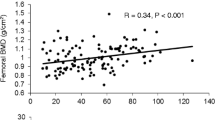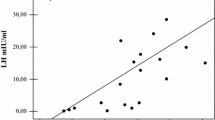Abstract
Background
Kallmann syndrome (KS) is a rare genetic condition characterized by congenital early-onset hypogonadotropic hypogonadism and anosmia or hyposmia. Male subjects are more frequently affected and present absent/delayed puberty, low testosterone levels with higher risk for osteoporosis. Therefore, to maintain normal levels of sex steroids and prevent bone loss, male KS needs life-long hormonal replacement therapy (HRT).
Aims
The objective of our study is to assess bone involvement in subjects with KS currently treated with HRT.
Methods
In our retrospective study, we analyzed data from medical records of patients with KS treated with HRT (either gonadotropins or testosterone preparations), including clinical history, biochemical parameters, and the following outcome measures: the bone mineral density (BMD) at the lumbar spine (LS), femoral neck (FN), and total body less head (TBLH); and the Vertebral Fracture Assessment (VFA) by Dual Energy X-ray Absorptiometry (DXA).
Results
Clinical and instrumental data of 32 patients with KS were evaluated; their mean age was 30.32 (±10.09) years, their mean body mass index (BMI) was 25.71 (±3.23) kg/m2. Four patients (12.5 %) had a LS BMD Z score below the expected range for age. Five patients had vertebral deformities observed at VFA. Duration of HRT was related to bone health parameters: BMD at all measured sites were higher in patients receiving adequate HRT for more than 2 years compared with the patients treated for less than 6 months. A deficient vitamin D status was found in 43 % of cases and it was prevalent in patients with shorter HRT.
Discussion and conclusion
Early starting and adequate duration of HRT are related to bone health parameters in patients with congenital hypogonadotropic hypogonadism due to KS. Restoring vitamin D sufficiency might also be advisable in this condition.

Similar content being viewed by others
References
Bonomi M, Libri DV, Guizzardi F, Idiopathic Central Hypogonadism Study Group of the Italian Societies of Endocrinology and Pediatric Endocrinology and Diabetes et al (2012) New understandings of the genetic basis of isolated idiopathic central hypogonadism. Asian J Androl 14:49–56
Network for Central Hypogonadism (Network Ipogonadismo Centrale, NICe) of Italian Societies of Endocrinology (SIE), of Andrology and Sexual Medicine (SIAMS) and of Peadiatric Endocrinology and Diabetes (SIEDP) (2014) Kallmann’s syndrome and normosmic isolated hypogonadotropic hypogonadism: two largely overlapping manifestations of one rare disorder. J Endocrinol Invest 37:499–500
Dodé C, Hardelin JP (2009) Kallmann syndrome. Eur J Hum Genet 17:139–146
Beranova M, Oliveira LM, Bédécarrats GY et al (2001) Prevalence, phenotypic spectrum, and modes of inheritance of gonadotropin-releasing hormone receptor mutations in idiopathic hypogonadotropic hypogonadism. J Clin Endocrinol Metab 86:1580–1588
Vanderschueren D, Vandenput L, Boonen S, Lindberg MK, Bouillon R, Ohlsson C (2004) Androgens and bone. Endocr Rev 25:389–425
Laitinen EM, Hero M, Vaaralahti K et al (2012) Bone mineral density, body composition and bone turnover in patients with congenital hypogonadotropic hypogonadism. Int J Androl 35:534–540
Han TS, Bouloux PM (2010) What is the optimal therapy for young males with hypogonadotropic hypogonadism? Clin Endocrinol (Oxf) 72:731–737
Wang C, Cunningham G, Dobs A et al (2004) Long-term testosterone gel (AndroGel) treatment maintains beneficial effects on sexual function and mood, lean and fat mass, and bone mineral density in hypogonadal men. J Clin Endocrinol Metab 89:2085–2098
Khosla S (2010) Update on estrogens and the skeleton. J Clin Endocrinol Metab 95:3569–3577
Nakamura T, Imai Y, Matsumoto T et al (2007) Estrogen prevents bone loss via estrogen receptor alpha and induction of Fas ligand in osteoclasts. Cell 130:811–823
Marcus R, Leary D, Schneider DL et al (2000) The contribution of testosterone to skeletal development and maintenance: lessons from the androgen insensitivity syndrome. J Clin Endocrinol Metab 85:1032–1037
Kawano H, Sato T, Yamada T et al (2003) Suppressive function of androgen receptor in bone resorption. Proc Natl Acad Sci USA 100:9416–9421
Smith EP, Specker B, Bachrach BE et al (2008) Impact on bone of an estrogen receptor-alpha gene loss of function mutation. J Clin Endocrinol Metab 93:3088–3096
Chiang C, Chiu M, Moore AJ et al (2009) Mineralization and bone resorption are regulated by the androgen receptor in male mice. J Bone Miner Res 24:621–631
Callewaert F, Boonen S, Vanderschueren D (2010) Sex steroids and the male skeleton: a tale of two hormones. Trends Endocrinol Metab 21:89–95
Petak SM, Nankin HR, Spark RF, Swerdloff RS, Rodriguez-Rigau LJ, American Association of Clinical Endocrinologists. American Association of Clinical Endocrinologists Medical guidelines for clinical practice for the evaluation and treatment of hypogonadism in adult male patients—2002 update. Endocr Pract (2002) 8(6):440–456. Erratum in: Endocr Pract (2008) 14(6):802–803. Petak, Steven M [added]; Nankin, Howard R [added]; Spark, Richard F [added]; Swerdloff, Ronald S [added]; Rodriguez-Rigau, Luis J [added]
Young J (2012) Approach to the male patient with congenital hypogonadotropic hypogonadism. J Clin Endocrinol Metab 97:707–718
Ottaviano G, Cantone E, D’Errico A et al (2015) Sniffin’ Sticks and olfactory system imaging in patients with Kallmann syndrome. Int Forum Allergy Rhinol. doi:10.1002/alr.21550
Manara R, Salvalaggio A, Favaro A, Kallmann Syndrome Neuroradiological Study Group et al (2014) Brain changes in Kallmann syndrome. AJNR Am J Neuroradiol 35:1700–1706
Schousboe JT, Shepherd JA, Bilezikian JP et al (2013) Executive summary of the 2013 International Society for Clinical Densitometry Position Development Conference on bone densitometry. J Clin Densitom 16:455–466
Genant HK, Wu CY, van Kuijk C et al (1993) Vertebral fracture assessment using a semiquantitative technique. J Bone Miner Res 8:1137–1148
Maestre de San Juan A (1856) Falta total de los nervios olfactorios con anosmía en un individuo en quien existia una atrofía congénita de los testículos y miembro viril. Siglo Medico 131:211
Kallmann FJ, Schoenfeld WA, Barrera SE (1944) The genetic aspects of primary eunuchoidism. Am J Ment Defici XLVIII:203–236
Taylor HS, Cass I, Lang R (1996) Bone loss in Kallmann syndrome. Obstet Gynecol 88:734
Raivio T, Sidis Y, Plummer L et al (2009) Impaired fibroblast growth factor receptor 1 signaling as a cause of normosmic idiopathic hypogonadotropic hypogonadism. J Clin Endocrinol Metab 94:4380–4390
Sinisi AA, Asci R, Bellastella G et al (2008) Homozygous mutation in the prokineticin-receptor2 gene (Val274Asp) presenting as reversible Kallmann syndrome and persistent oligozoospermia: case report. Hum Reprod 23:2380–2384
Seminara SB, Hayes FJ, Crowley WF Jr (1998) Gonadotropin-releasing hormone deficiency in the human (idiopathic hypogonadotropic hypogonadism and Kallmann’s syndrome): pathophysiological and genetic considerations. Endocr Rev 19:521–539
Finkelstein JS, Klibanski A, Neer RM et al (1987) Osteoporosis in men with idiopathic hypogonadotropic hypogonadism. Ann Intern Med 106:354–361
Behre HM, Kliesch S, Leifke E et al (1997) Long-term effect of testosterone therapy on bone mineral density in hypogonadal men. J Clin Endocrinol Metab 82:2386–2390
Dohle GR, Arver S, Bettocchi C, Jones TH, Kliesch S, Punab M (2015) Guidelines on male hypogonadism. European Association of Urology.http://uroweb.org/wp-content/uploads/18-Male-Hypogonadism_LR1.pdf. Accessed 13 July 2015
Giuffrida G, Cappellini MD, Carubbi F et al (2014) Management of bone disease in Gaucher disease type 1: clinical practice. Adv Ther 31:1197–1212
Singh P (2013) Andropause: current concepts. Indian J Endocrinol Metab 17:S621–S629
Foresta C, Strapazzon G, De Toni L et al (2011) Bone mineral density and testicular failure: evidence for a role of vitamin D 25-hydroxylase in human testis. J Clin Endocrinol Metab 96:E646–E652
Steingrimsdottir L, Gunnarsson O, Indridason OS et al (2005) Relationship between serum parathyroid hormone levels, vitamin D sufficiency, and calcium intake. JAMA 294:2336–2341
Author information
Authors and Affiliations
Corresponding author
Ethics declarations
Conflict of interest
On behalf of all authors, the corresponding author states that there is no conflict of interest. No funding was received in support of this study.
Ethical approval
All procedures performed in studies involving human participants were in accordance with the ethical standards of the institutional and/ or national research committee and with the 1964 Helsinki declaration and its later amendments or comparable ethical standards.
Informed consent
For this type of study formal consent is not required.
Rights and permissions
About this article
Cite this article
Iolascon, G., Frizzi, L., Bianco, M. et al. Bone involvement in males with Kallmann disease. Aging Clin Exp Res 27 (Suppl 1), 31–36 (2015). https://doi.org/10.1007/s40520-015-0421-5
Received:
Accepted:
Published:
Issue Date:
DOI: https://doi.org/10.1007/s40520-015-0421-5




